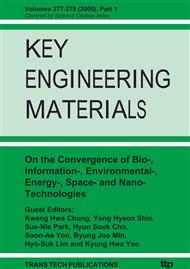p.497
p.503
p.510
p.517
p.523
p.528
p.536
p.542
p.548
Carbon Isotope Ratio Measurement on Foxtail Seed as an Environmental Index
Abstract:
The carbon isotope ratios in foxtail seeds, which grow well anywhere such as a residential street, roadside, empty lot, field etc., were measured by EA/IRMS (Elemental Analyzer/ Isotope Ratio Mass Spectrometer). The samplings were carried out in two ways. One set of foxtail seeds was sampled at 11 different locations to examine the effect of the traffic frequency in Daejeon and its suburbs. The other set was collected in three separate areas to examine the distance effect from the roadside. The d13C values of foxtails were increased at a distance from the center of Daejeon City. According to the results for the other set to examine the distance effect from the roadside, the d13C values of foxtails grown close to the roads were lower than those far away from the road. It means that the roadside foxtails are highly affected by automobile exhaust gases. This effect strongly decreased as the distance from the road increased, because the pollution gases by the vehicles diluted well with the air, even at 5 m from the road. We propose that these results can be used in the monitoring of the hazardous atmospheric pollutants caused by fossil fuel in addition to the monitoring of carbon dioxide.
Info:
Periodical:
Pages:
523-527
Citation:
Online since:
January 2005
Authors:
Price:
Сopyright:
© 2005 Trans Tech Publications Ltd. All Rights Reserved
Share:
Citation:


